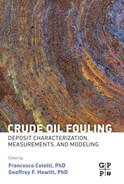Book Description
With production from unconventional rigs continuing to escalate and refineries grappling with the challenges of shale and heavier oil feedstocks, petroleum engineers and refinery managers must ensure that equipment used with today’s crude oil is protected from fouling deposits Crude Oil Fouling addresses this overarching challenge for the petroleum community with clear explanations on what causes fouling, current models and new approaches to evaluate and study the formation of deposits, and how today’s models could be applied from lab experiment to onsite field usability for not just the refinery, but for the rig, platform, or pipeline.
Crude Oil Fouling is a must-have reference for every petroleum engineer’s library that gives the basic framework needed to analyze, model, and integrate the best fouling strategies and operations for crude oil systems.
- Defines the most critical variables and events that cause fouling
- Explains the consequences of fouling and its impact on operations, safety, and economics
- Provides the technical models available to better predict and eliminate the potential for fouling in any crude system
Table of Contents
- Cover image
- Title page
- Table of Contents
- Copyright
- List of Contributors
- Preface
- Nomenclature
- Chapter One. Introduction
- Chapter Two. Basic Science of the Fouling Process
- Chapter Three. Experimental Generation of Fouling Deposits
- Chapter Four. Deposit Characterization and Measurements
- Chapter Five. Modeling of Fouling from Molecular to Plant Scale
- Chapter Six. Concluding Remarks
- Appendix 1
- References
- Index
